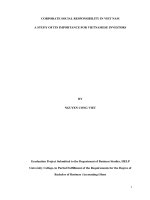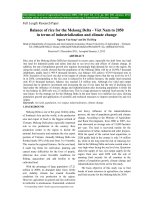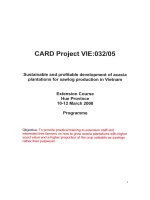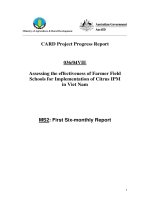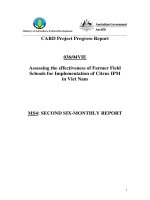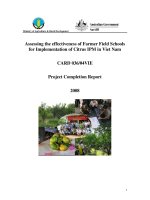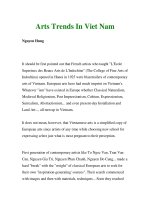Develop brand love for fashion brabd in viet nam
Bạn đang xem bản rút gọn của tài liệu. Xem và tải ngay bản đầy đủ của tài liệu tại đây (597.81 KB, 11 trang )
International Journal of Management (IJM)
Volume 11, Issue 6, June 2020, pp. 1336-1346, Article ID: IJM_11_06_122
Available online at />ISSN Print: 0976-6502 and ISSN Online: 0976-6510
DOI: 10.34218/IJM.11.6.2020.122
© IAEME Publication
Scopus Indexed
DEVELOP BRAND LOVE FOR FASHION
BRANDS IN VIET NAM
Quynh Mai Nguyen
Faculty of Business Administration - Industrial University of Ho Chi Minh City
12 Nguyen Van Bao, Ward 4, Go Vap District, Ho Chi Minh City, Viet Nam
Thi Phuong Thanh Nguyen
Faculty of Business Administration - University of Economics Ho Chi Minh City
59C Nguyen Dinh Chieu, Ward 6, District 3, Ho Chi Minh City, Viet Nam
ABSTRACT
The study aims to assess the influence of celebrity image (CI) on social media
advertising (SMA) and the impacts of SMA on brand love in the Viet Nam fashion
industry. The paper uses the quantitative method, with 450 offline responses.
Cronbach’s Alpha, Exploratory Factor Analysis (EFA), Confirmatory Factor Analysis
(CFA), Structural Equation Modeling (SEM) using AMOS are analyzed. The results
indicate that the relevance of CI is the most powerful factor on SMA, followed by the
attractiveness and expertise. The SMA has positive influence on brand love. It is
essential for many fashion brands in Viet Nam to increase brand love by focusing on
the SMA tools with the development of brand’s CI (attractiveness, expertise and
relevance).
Key words: Brand love, Celebrity image, Fashion brand, Social media advertising
Cite this Article: Quynh Mai Nguyen and Thi Phuong Thanh Nguyen, Develop
Brand Love for Fashion Brands in Viet Nam, International Journal of Management,
11(6), 2020, pp. 1336-1346.
/>
1. INTRODUCTION
The fashion industry was worth up to 2.5 trillion US dollars to the international economy
(Joint Economic Committee of the United States Congress, 2019). With the advances in the
technologies and social media networks, customers can feel inspired, express their personal
styles (Casaló et al., 2020) and discuss the new tendency of fashion with other people
(Brandão et al., 2019). Consumer-brand relationship has attracted different researchers for
many years. Previous examination on celebrity endorsement strategy makes valuable
contributions, for example, the importance of celebrity endorsement in the fashion market
(Wigley, 2015), the influence of celebrities on behavior of consumer (Wongweeranonchai and
McClelland, 2016). Nevertheless, the various potentials for fashion branding topic are still
/>
1336
Electronic copy available at: />
Develop Brand Love for Fashion Brands in Viet Nam
developing expectedly reference and academic research on the relationship between celebrity
image, social media advertising and consumers’ brand love in Ho Chi Minh City, Viet Nam is
infrequently discussed.
Our study aims to investigate the influence of celebrity image on social media advertising
and evaluate the predictive power of the social media advertising to describe consumers’
brand love in their psychology in the Viet Nam fashion industry. The existing examination
does not fully clarify the reason for this approach’s efficiency. However, an academic study
on the influence of celebrity image on social media evaluation tools is still in its infancy. Few
examinations have studied the impact of a detailed dimension of social media advertising on
consumers’ psychological path to a brand in Viet Nam. Therefore, this mediation effect of
social media advertising appeal between celebrity image and consumers’ brand love in Viet
Nam fashion industry, which thoroughly deserve to have further exploration.
2. OBJECTIVES OF THE STUDY
There are two objectives to lead this investigation:
•
To analyze the impacts of celebrity image on social media advertising
•
To assess the influence of social media advertising on consumers’ brand love in the
Viet Nam fashion industry.
3. LITERATURE REVIEW
3.1. Brand Love
Brand love is regarded as consumers’ emotional desire, connection and commitment to a
specific brand and helps long-term relationship between the consumer and brand become
intimate (Batra et al., 2012). Carroll and Ahuvia (2006) define that brand love is a passionate
and optimistic emotion for a particular brand created by an effective communication between
the consumer and their brand and a brand which consumers consider as the hedonic product
has a positive impact on brand. Over the last 5–10 years, for the context of fashion industry,
consumers have loved their fashion brand due to its desire inspires in them (Ismail and
Spinelli, 2012). The brand love creation plays a major role to experts since those satisfied
customers can be loyal customers (Gumparthi and Patra, 2019). Hence, brand love
conceptualization can form as adoring feelings and emotion for a specific brand, which guides
to commitment or loyalty.
3.2. Celebrity Image
The celebrity image is defined by information written about him/her, image used in the
various contexts and how he/she becomes a part of speech in daily life (Lammie, 2007).
Garud (2013) and Knott and James (2004) analyzed that source celebrity credibility, had its
origin in the Hovland et al. (1953) study, was the main element to select celebrities. In the
Hovland and his associates’ research, expertise and trustworthiness were two factors effecting
the celebrity’s effectiveness. Besides, Ohanian (1990) investigated the source attractiveness
model, originated by “source valance” model (Mcquire, 1985). In this model, the
attractiveness dimension was added to source credibility model because of its meanings to the
celebrity image. Chang (2014) proposes that the likability, relevance and expertise are chosen
to evaluate the effectiveness of spokes-character. Therefore, based on theoretical framework
of celebrity image and earlier studies, attractiveness, expertise and relevance are three
dimensions to measure the characteristics of celebrity image.
/>
1337
Electronic copy available at: />
Quynh Mai Nguyen and Thi Phuong Thanh Nguyen
3.3. Social Media Advertising
Over the past many years, social media advertising has been described as the practice
involving the paid advertisements’ use on social networking sites such as Facebook, Twitter,
YouTube (The Social Media Advertising Industry Report, 2013). He and Qu (2018) highlight
that the advertising appeal is the external motivation and the social media is the large
environment. Also, in the social media environment, the impacts of the advertising appeal on
consumers’ attitude are discovered. Raji et al. (2018) demonstrate that the scales of social
media advertising have substantial benefits of trustworthiness. Therefore, this research
considers that social media advertising being measured by that scales is one of the key
elements that decides consumers’ psychology.
3.4. The Relationship between Celebrity Image, Social Media Advertising and
Brand Love
With the expansion of different marketing media such as social media, mass media, many
brands try an effort to acquire and retain their customers by establishing customers' brand
communication, for example, brand love and brand trust (Huang, 2017). Through blogs and
Facebook brand pages, these fashion apparel companies can attract and continue
conversations with customers in order to identify accurately which brands customers love
(Islam and Rahman, 2016). Park and Kim (2015) indicate that there is an optimistic
relationship between social media activity and brand loyalty which is positively affected by
brand love (Bergkvist and Bech-Larsen, 2010). Thanks to social media, a fashion brand can
establish a great synergy (Parrott et al., 2015).
4. PROPOSED RESEARCH MODEL AND DEVELOPMENT OF
HYPOTHESES
4.1. Proposed Research Model
Based on the framework of brand love, social media advertising and celebrity image theory,
this investigation validates the mediating effect of social media advertising between celebrity
image and brand love. The research model is proposed, as follows:
Figure 1 Research Model
4.2. Development of hypotheses
4.2.1. The influence of celebrity image on the social media advertising
Celebrity image has a major role to confirm the success of social media advertising
(Djafarova and Rushworth, 2017). Mozo (2019) describes that the celebrity image is regarded
as a “constructed personage” – a “complex configuration of visual, verbal, and aural signs”
through different media texts. Based on the source credibility model (Hovland et al., 1953),
the source attractiveness model (Ohanian, 1990) and later studies (Wongweeranonchai and
/>
1338
Electronic copy available at: />
Develop Brand Love for Fashion Brands in Viet Nam
McClelland, 2016), attractiveness, expertise and relevance were highlighted as
three dimensions to measure the characteristics of celebrity image. Some representative items
of attractiveness included “I feel celebrity image fashionable”, “Celebrity image makes me
feel young” and “Celebrity image makes me feel energetic”. Some representative items of
expertise included “The image of celebrity looks professional”, “The image of celebrity looks
experienced” and “The image of celebrity looks knowledgeable”. Some representative items
of relevance included “Celebrity is appropriate to endorse the product of fashion brand”, “It
makes sense for celebrity image to be featured with a fashion brand” and “I feel that celebrity
image is relevant for a fashion brand”.
Thanks to the internet and extensive coverage of Web 2.0 technologies, for example,
YouTube, Facebook, Instagram, Twitter, celebrities are communicating their fashions to fans
with various ways (Iqbal, 2019). The audience includes the celebrity’s admirers on social
media can trust celebrity's advertisement because celebrities use, review and suggest these
products (Qabur, 2018). Nataraajan and Chawla (1997) demonstrate the celebrity’s
attractiveness has created the celebrity endorsements ‘advertising effect for decades. The
expertise standard can be recognized a close interaction between social media user and
celebrity (Zhao et al., 2016). In recent times, social media companies have considered
celebrity as an advertising channel to develop their brands because of the congruence between
products and celebrity endorsers (Branchik and Chowdhury, 2017). Thus, various hypotheses
are proposed:
H1a. The attractiveness of celebrity image has a positive effect on social media advertising
H1b. The expertise of celebrity image has a positive effect on social media advertising
H1c. The relevance of celebrity image has a positive effect on social media advertising
4.2.2. The influence of social media advertising on the brand love
The scales of social media advertising had substantial benefits of trustworthiness (Raji et al.,
2018) Therefore, in this research, four observed variables of social media advertising factor
come from Raji (2018) and associates (where it was shown with reliability of 0.887). Some
representative items were “The advertisement on social media are creative”, “The
advertisement on social media gives me useful information” and “The advertisement on social
media offers me something new”. Sikandar and Ahmed (2019) show that how various social
media advertising components make a powerful impact on creating brand love. From the
context contributed by Facebook, social media marketing activities beneficially influence selfexpressive brands, which makes an impact brand love (Algharabat Raed, 2017). Due to a
quick review of social media, Facebook and fan page, this examination studies “liking” a fan
page considerably impacts brand love of the brands (Kudeshia et al., 2015). Through blogs
and Facebook brand pages, these fashion apparel companies can attract and continue
conversations with customers in order to identify accurately which brands customers love
(Islam and Rahman, 2016). Brand love was measured by six observed variables derived from
(Carroll and Ahuvia, 2006), which had all items’ reliabilities greater than 0.9. Representative
items were “This fashion brand is my favorite brand”, “This fashion brand makes me young”
and “This fashion brand is a true happiness”. Therefore, the subsequent hypothesis is posited:
H2. The social media advertising has a positive effect on consumers’ brand love
/>
1339
Electronic copy available at: />
Quynh Mai Nguyen and Thi Phuong Thanh Nguyen
5. METHODOLOGY
5.1. Measurement
In this investigation, the quantitative research instrument was a questionnaire drawn up based
on available scales. All scales and observed variables were collected from previous
examination and modified to be appropriate for the background of celebrity image in the
fashion industry. Therefore, the reliability and validity of survey questionnaire were
effectively guaranteed. The research’s independent variables are attractiveness, expertise and
relevance, mediator variable is social media advertising and dependent variable is brand love.
Firstly, based on the source credibility model (Hovland et al., 1953), the source attractiveness
model (Ohanian, 1990) and later studies (Chang, 2014) attractiveness, expertise and
relevance were highlighted as three dimensions to measure the characteristics of celebrity
image. Secondly, the scales of social media advertising had substantial benefits of
trustworthiness (Raji et al., 2018). Finally, brand love was measured by six observed variables
derived from (Carroll and Ahuvia, 2006).
5.2. Samples Size and Data Collection
This study uses the quantitative research method by obtained data from consumers of local
fashion brands in Ho Chi Minh City. The target population of the research is people who are
fashion-conscious and customers of local fashion brands in Ho Chi Minh City, in age from 18
to 45. About 36.2% of Ho Chi Minh city’s population are interested in fashion (Vinaresearch,
2019), the population used in this research is about 3.258 million. Thus, the appropriate
sample size of investigation is approximately 400 questionnaires (Yamane’s formula).
Data in the quantitative research was gathered by using a paper-based surveys, with 450
offline responses. The questionnaire survey was conducted two times (a pilot study first and
official surveys afterwards) to confirm the sample’s quality. The pilot survey made with 20
questionnaires was conducted among customers of local fashion brands in Ho Chi Minh City.
Subsequently, Cronbach’s Alpha of every factor was analyzed to ensure the reliability of
scales and observed variables (Kawa and Maryniak, 2018). In the official surveys, this study
conducted a survey in many well-known local fashion brands in Ho Chi Minh City. In
quantitative research, Cronbach’s Alpha reliability coefficients, Exploratory Factor Analysis
(EFA), Confirmatory Factor Analysis (CFA), Structural Equation Modeling (SEM) using
AMOS were analyzed to investigate various factors influence on consumers’ brand love,
using celebrity image and social media evaluation tools in the Viet Nam fashion industry.
6. RESULTS AND DISCUSSION
6.1. Reliability Analysis (Cronbach’s Alpha Coefficients)
Table 1 Cronbach's Alpha Result
Items
ATT1
ATT2
ATT3
ATT4
REL1
REL2
Corrected
Scale
Item-Total
Scale Mean if
Variance if
Correlation
Item Deleted Item Deleted
coefficients
1. Attractiveness: α = 0.871
10.47
5.579
.670
10.42
5.491
.816
10.16
5.698
.761
10.23
6.081
.666
2. Relevance: α = 0.836
6.62
2.074
.674
6.68
1.777
.792
/>
1340
Cronbach's
Alpha if Item
Deleted
.861
.799
.821
.858
.796
.676
Electronic copy available at: />
Develop Brand Love for Fashion Brands in Viet Nam
REL3
EXP1
EXP2
EXP3
SM2
SM3
SM4
BL1
BL2
BL3
BL4
BL6
6.65
2.006
.636
3. Expertise: α = 0.855
6.77
2.155
.758
6.79
2.100
.741
6.70
2.210
.685
4. Social media advertising: α = 0.857
7.26
2.225
.678
7.25
2.100
.779
7.29
2.248
.735
5. Consumers’ local brand love: α = 0.894
15.44
6.464
.678
15.43
6.272
.728
15.52
6.535
.688
15.51
6.040
.820
15.49
6.102
.786
.835
.769
.785
.837
.848
.752
.795
.885
.873
.882
.853
.860
Every extracted factor’s reliability analysis was created by using Cronbach’s alpha (Kawa
and Maryniak, 2018). Attractiveness, expertise and relevance are three scales of celebrity
image. Cronbach’s Alpha coefficients are greater than 0.8 (0.871, 0.836, 0.855 respectively).
All observed variables ‘correlation coefficients are greater than 0.3, which shows that three
scales guarantee reliability. Secondly, Cronbach’s Alpha coefficient of social media
advertising is 0.857 (greater than 0.8). The requirements for most observed variables’
correlation coefficients are satisfied, greater than 0.3. Nevertheless, total correlation
coefficients of SM1 variable is 0.291 (less than 0.3), so SM1 is removed. Cronbach’s Alpha
coefficient of brand love is 0.894 (greater than 0.8). The requirements for various observed
variables’ correlation coefficients are fulfilled, greater than 0.3. Nonetheless, BL5 has total
correlation coefficients of 0.254 (less than 0.3), so BL5 is removed. Hence, the celebrity
image, social media advertising and brand love can be used to perform the Exploratory Factor
Analysis.
6.2. Exploratory Factor Analysis (EFA)
Table 2 KMO and Bartlett's Test
KMO and Bartlett's Test
Kaiser-Meyer-Olkin Measure of Sampling Adequacy.
Bartlett's Test of Sphericity
Approx. Chi-Square
df
Sig.
.841
3126.738
153
.000
As can be seen from the Table 2 and Table 3, the factor loading of observed variables are
greater than 0.5. The percentage of variance extracted is higher than 50%. Kaiser-MeyerOlkin (KMO) value is 0.841 (between 0.5 and 1). Hence, the factor analysis is proper to the
investigation data and the sampling is adequate. Bartlett's test having Sig. value of 0.000 (less
than 0.05) explains the correlation between these observed variables in the overall. Thus, all
factors in this research fulfill the requirement.
/>
1341
Electronic copy available at: />
Quynh Mai Nguyen and Thi Phuong Thanh Nguyen
Table 3 Pattern Matrix
BL4
BL6
BL2
BL3
BL1
ATT2
ATT3
ATT1
ATT4
EXP1
EXP2
EXP3
SM3
SM4
SM2
REL2
REL1
REL3
Pattern Matrixa
Factor
2
3
1
.938
.872
.713
.713
.667
4
5
.893
.855
.713
.712
.872
.815
.746
.895
.800
.739
.990
.700
.686
6.3. Confirmatory Factor Analysis (CFA)
Figure 2 CFA standardized model
As is illustrated in the Figure 2, the confirmatory factor analysis results describe that there
are 125 degrees of freedom and the data are appropriate a hypothesized measurement model.
Chi-square/ df = 2.310 (less than 3); p= 0.000; CMIN/df = 2.310 (less than 3); GFI = 0.901
(greater than 0.8); CFI = 0.946 (higher than 0.9) and TLI = 0.934 (greater than 0.9); RMSEA
= 0.067 (less than 0.08)
6.4. Structural Equation Modeling (SEM)
According to the test results of model fit, all observed and potential variables are established
in the model to check the hypotheses. As can be highlighted from the Figure 3: Chi-square/ df
= 1.978 (less than 3); p= 0.000; GFI = 0.917 (greater than 0.8); CFI = 0.959 (higher than 0.9)
/>
1342
Electronic copy available at: />
Develop Brand Love for Fashion Brands in Viet Nam
and TLI = 0.951 (greater than 0.9); RMSEA = 0.058 (less than 0.08). These indices are
fulfilled the conditions of model fit.
Figure 3 SEM results (standardized)
6.5. Hypothesis Testing
As is seen from the Table 4, the hypothesis testing comprises three factors of celebrity image
(attractiveness _ ATT, expertise _ EXP and relevance _ REL), which impacts on brand love
(BL) with statistical significance (P<0.05). Also, the hypothesis analyzing of both social
media advertising (SM) effect on BL with statistical significance (P<0.05). Finally, the
hypothesis testing of ATT, EXP and REL influence on SM with statistical significance
(P<0.05). Hence, these investigation hypotheses H1a, H1b, H1c and H2 are supported.
Table 4 Hypothesis testing
Regression Weights
SM
SM
SM
BL
<--<--<--<---
ATT
EXP
REL
SM
Estimate
.204
.185
.247
.502
SE.
.054
.072
.068
.056
CR.
3.787
2.571
3.642
8.907
P
***
.010
***
***
Standardized Regression
Weights
Estimate
SM <--- ATT
.244
SM <--- EXP
.172
SM <--- REL
.250
BL <--- SM
.541
7. CONCLUSION
These hypotheses of celebrity’s attractiveness, expertise and relevance has a positive
influence on the social media advertising are proposed. Furthermore, the hypothesis of social
media advertising which is intermediate between celebrity image and brand love is supported.
The results of study indicate that three factors included attractiveness, expertise and relevance
can be used to measure the celebrity image. Additionally, social media advertising and brand
love’s scales are supported with a high reliability and validity. In this research, the relevance
of celebrity image is the most powerful factor on social media advertising with standardized
coefficient of beta of 0.250, followed by the attractiveness with the standardized coefficient of
beta of 0.244, and the expertise with standardized coefficient of beta of 0.172. The social
/>
1343
Electronic copy available at: />
Quynh Mai Nguyen and Thi Phuong Thanh Nguyen
media advertising is the factor on brand love with standardized coefficient of beta of 0.541.
Hence, it is necessary for many fashion brands to increase brand love by concentrating on
advertising on the social media tools with the development of brand’s celebrity image
(attractiveness, expertise and relevance) and the relevance is the most influential factor on
social media advertising. There are some limitations in this research. Due to the strong
impacts of local well-known celebrity, the influence of various celebrity image can have some
differences between different industries in Viet Nam so it is essential for further research to
test this impacts of celebrity image on brand love in various industries.
REFERENCES
[1]
The Social Media Advertising Industry Report. (2013) The Nielsen Company.
[2]
Algharabat Raed, S. (2017). Linking social media marketing activities with brand love:
The mediating role of self-expressive brands. Kybernetes, 46, 1801-1819.
[3]
Batra, R., Ahuvia, A. & Bagozzi, R. P. (2012). Brand Love. Journal of Marketing, 76, 116.
[4]
Bergkvist, L. & Bech-Larsen, T. (2010). Two Studies of Consequences and Actionable
Antecedents of Brand Love. Journal of Brand Management, 17 (7), 504-518, 17.
[5]
Branchik, B. J. & Chowdhury, T. G. 2017. Men seeing stars: Celebrity endorsers, race,
and the male consumer. Journal of Marketing Theory and Practice, 25, 305-322.
[6]
Brandão, A., Pinho, E. & Rodrigues, P. (2019). Antecedents and consequences of luxury
brand engagement in social media. Spanish Journal of Marketing, 23, 163-218.
[7]
Carroll, B. A. & Ahuvia, A. C. (2006). Some antecedents and outcomes of brand love.
Marketing letters, 17, 79-89.
[8]
Casaló, L., Flavián, C. & Ibáñez-Sánchez, S. (2020). Be creative, my friend! Engaging
users on Instagram by promoting positive emotions. Journal of Business Research.
[9]
Chang, E.-C. (2014). Influences of the spokes-character on brand equity antecedents. Asia
Pacific Journal of Marketing and Logistics.
[10]
Djafarova, E. & Rushworth, C. (2017). Exploring the credibility of online celebrities'
Instagram profiles in influencing the purchase decisions of young female users. .
Computers in Human Behavior, 68, 1-7.
[11]
Garud, U. (2013). An Impact of Product Advertisement and Celebrity Endorsement on
Consumer Buying Behavior and Building Brand Image–A Study among Professional
Students. SIT journal of management, 3, 247-257.
[12]
Gumparthi, V. P. & Patra, S. (2019). The Phenomenon of Brand Love: A Systematic
Literature Review. Journal of Relationship Marketing, 1-40.
[13]
He, Q. & Qu, H. (2018). The Impact of Advertising Appeals on Purchase Intention in
Social Media Environment. Journal of Business Administration Research, 7, 17.
[14]
Hovland, C. I., Janis, I. L. & Kelley, H. H. (1953). Communication and persuasion.
[15]
Huang, C.-C. (2017). The impacts of brand experiences on brand loyalty: mediators of
brand love and trust. Management Decision, 55, 915-934.
[16]
Iqbal, F. (2019). A human fashion brand model to define critical symbiotic relationships
for celebrity fashion emulation. The University of Salford.
[17]
Islam, J. U. & Rahman, Z. (2016). Examining the effects of brand love and brand image
on customer engagement: An empirical study of fashion apparel brands. Journal of Global
Fashion Marketing, 7, 45-59.
/>
1344
Electronic copy available at: />
Develop Brand Love for Fashion Brands in Viet Nam
[18]
Ismail, A. R. & Spinelli, G. (2012). Effects of brand love, personality and image on word
of mouth. Journal of Fashion Marketing and Management: An International Journal.
[19]
Kawa, A. & Maryniak, A. (2018). SMART Supply Network.
[20]
Knott, C. & James, M. S. (2004). An alternate approach to developing a total celebrity
endorser rating model using the analytic hierarchy process. International transactions in
operational research, 11, 87-95.
[21]
Kudeshia, C., Sikdar, P. & Mittal, A. (2015). Spreading love through fan page liking: A
perspective on small scale entrepreneurs. Computers in Human Behavior, 54, 257-270.
[22]
Lammie, K. E. (2007). The (not-so)“powerless elite” celebrity endorsements of political
candidates. University of Pennsylvania.
[23]
Mcquire, W. J. (1985). Attitude and Attitude Change., New york, Random House.
[24]
Moreno-Gavara, C. & Jiménez-Zarco, A. (2018). Strategies for Luxury Fashion Brands'
Targeting the Young Audience: How to Link Celebrity Endorsements and Brand
Extensions With Social Media. Fashion and Textiles: Breakthroughs in Research and
Practice. IGI Global.
[25]
Mozo, M. S. (2019). Why James Reid is better than I’: A critical discourse analysis of the
celebrity image as a text and commodity. University of the Philippines College of Mass
Communication. .
[26]
Nataraajan, R. & Chawla, S. K. (1997). “Fitness” marketing: celebrity or non-celebrity
endorsement? Journal of professional services marketing, 15, 119-129.
[27]
Ohanian, R. (1990). Construction and validation of a scale to measure celebrity endorsers'
perceived expertise, trustworthiness, and attractiveness. Journal of advertising, 19, 39-52.
[28]
Park, H. & Kim, Y.-K. (2015). Can a fashion brand be social?: The role of benefits of
brand community within social network sites. Journal of Global Fashion Marketing, 6,
75-86.
[29]
Parrott, G., Danbury, A. & Kanthavanich, P. (2015). Online behaviour of luxury fashion
brand advocates. Journal of Fashion Marketing and Management.
[30]
Qabur, I. (2018). Factors Influencing Efficacy of Celebrity Endorsement in Saudi Arabia.
Cleveland State University.
[31]
Raji, R. A., Rashid, S. M. & Sobhi, I. M. (2018). Assessing validity and internal
consistency of the social media marketing communication measurement scales. e-Bangi,
14.
[32]
Sikandar, M. D. I. & Ahmed, Q. M. (2019). Impact of Social Media Marketing on Brand
Love: Promoting Loyalty in the Restaurant Landscape of Pakistan. Online Journal of
Communication and Media Technologies, 9, e201927.
[33]
Vinaresearch. (2019). Survey about Vietnamese's consumption habits and fashion style
[Online]. Viet Nam. [Accessed].
[34]
Wigley, S. (2015). An Examination of Contemporary Celebrity Endorsement in Fashion.
International Journal of Costume and Fashion, 15, 1-17.
[35]
Wongweeranonchai, P. & McClelland, R. J. (2016). The Influence of Perceived Celebrity
Endorser Credibility in Advertising on Purchase Intention of Thai Consumers. Journal of
Communication and Innovation, 3.
[36]
Zhao, W. X., Liu, J., He, Y., Lin, C.-Y. & Wen, J.-R. (2016). A computational approach
to measuring the correlation between expertise and social media influence for celebrities
on microblogs. World Wide Web, 19, 865-886.
/>
1345
Electronic copy available at: />
Quynh Mai Nguyen and Thi Phuong Thanh Nguyen
[37]
Dr. Govind Dave and Binit Patel, (2016) A Study of Corporate Branding and its Impact on
Consumers’ Loyalty. International Journal of Advanced Research in Management, 7(2),
pp. 11–19.
[38]
Dr B Prasanna Soundari and R Sabari Shankar, (2019) Brand Personality of Coimbatore:
Tourists Insights as a Tool for Destination Branding, Journal of Management, 6(2), pp.
45–49.
[39]
Dr. M. Saravanakumar, (2012) A Study on Branding Strategies of Knitwear Selected
Units in Tirupur, International Journal of Management, 3(1), pp. 254–261
[40]
Deepti Verma, Chetna Verma, (2015) A Study on Attractiveness Dimensions of Employer
Branding in Technical Educational Institutions, International Journal of Marketing and
Human Resource Management, 6(1), pp. 36–43
/>
1346
Electronic copy available at: />

